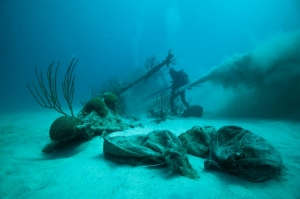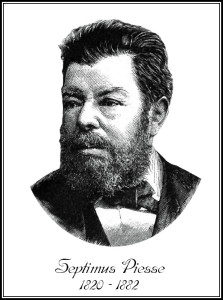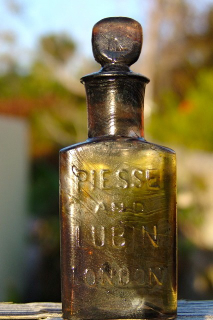Photo: Chris Burville for LookBermuda
In February 2011, a strong winter storm exposed and removed a stable sediment layer deep within the intact bow section of the shipwreck Mary Celestia, a Civil War Blockade Runner sunk in 1864 off the south shore of Bermuda in 55 feet of water. Four months later, over a seven-day excavation, a local and international team of marine archaeologists, co-led by Philippe Max Rouja, (Bermuda’s Custodian of historic shipwrecks), James Delgado (NOAA) and Dominique Rissollo (Waitt Institute) uncovered and rescued a small cache of hidden artifacts from the Mary Celestia, including perfume bottles embossed Piesse & Lubin London.
G.W. Piesse
Piesse & Lubin was a prominent perfume house on Bond Street in London, England at the time the Mary Celestia sank. G.W. Piesse was a chemist, perfumer and a prolific writer who wrote, among other scientific books, The Art of Perfumery, the first modern book about perfumery in 1857. Piesse was one of the first to openly describe and publish many of his highly influential techniques and formulas. It is not known if any of his perfumes have survived to the present day, meaning that the specimens in the sealed bottles from the Mary Celestia might represent the only known and testable samples of a Piesse perfume available to perfume historians and chemists. Bermuda is fortunate to have a long and distinguished history in the development, manufacture and marketing of fragrances and that history is embodied in the 86 year-old Bermuda Perfumery.
Photo Caption: Sealed, full and intact bottle of "Piesse and Lubin" perfume recovered from the shipwreck of the Civil War Blockade Runner "Mary Celestia" sunk under mysterious circumstances in September 1864 on the South Shore of Bermuda.
In April 2013, the Perfumery’s director Isabelle Ramsay-Brackstone hand-carried two of the Piesse & Lubin perfume bottles to the laboratories of drom Fragrances in New Jersey, where they were opened and their contents analyzed via a gas chromatograph under the watchful eyes of Jean-Claude Delville and Lionel Nesbitt. The results of the analysis showed that both bottles contained the same fragrance and miraculously after 150 years underwater were uncontaminated with salt water. The smell of the fragrance was overwhelming of rotten citrus with some notes of hydrogen sulfide (commonly known as rotten eggs).
The perfumers characterized the smell as unpleasant however to the amateur nose of the archaeological researchers the smell was characterized as surprisingly citrus, grapefruity, and inoffensive. Some impressions of orange flower, geranium, orris, bois de rose, opoponax, sandalwood and benzoin were also recognized with a dry-down of civet and ambergris tincture. Although the liquids contained in the bottles were intact and had not been contaminated by salt water, many of the essential oils contained in the fragrance had broken down through the many years under the sea. At this time, the analysis of the fragrance found did not allow the researchers to determine the identity of the fragrance with certainty, as the earliest reference of the collection of Piesse & Lubin dates back to 1873. However, it appears that the time Mary Celestia wrecked, “Bouquet Opoponax”, launched in 1859, was the most popular fragrance of Piesse & Lubin. Although the perfume house never received the prestigious “Royal Warrant Seal” from the British government, it is clear that Piesse’s fragrances were admired and coveted even in the American South at the height of the American Civil War.
The successful transport of luxury goods through the Blockade assured a premium on the black market once in the Confederate South. The trade in such items had been considered a viable activity for the crew risking their liberty and lives running the blockade. However at the time of the Mary Celestia’s sinking the transport of luxury goods on Runners had been banned by the Confederate government leading to speculation by the research team that these goods, found in the very tip of the bow of the ship away from general cargo, had been carefully hidden by one of the crew. The small, tight area in the strong forepeak hid the goods from salvors and protected them from hurricane damage for the next 150 years. This providential discovery carves a literal window into the world of British built and Southern backed Blockade Runners, their pivotal role in the US Civil War and the complex lives of the people and goods – including perfume – they transported that will be the subject of a feature length documentary currently in production between producers LookBermuda and PBS member station, South Carolina Educational Television.
(Authors: Isabelle Ramsay-Brackstone, The Bermuda Perfumery; Philippe Rouja, Bermuda Department of Conservation Services; Jean-Claude Delville & Lionel Nesbitt, drom; James Delgado National Oceanic & Atmospheric Administration; Dominique Rissolo, Waitt Institute)
Via press release
Editor’s Note: I was going to edit this but the press release from the Bermuda Perfumery Co, is so compelling; I left every word intact.–Michelyn Camen, Editor in Chief. The rescued Piesse Lubin perfume will be on display in Bermuda at The Bermuda Perfumery and possibly in New York City later this month, for a limited time.



